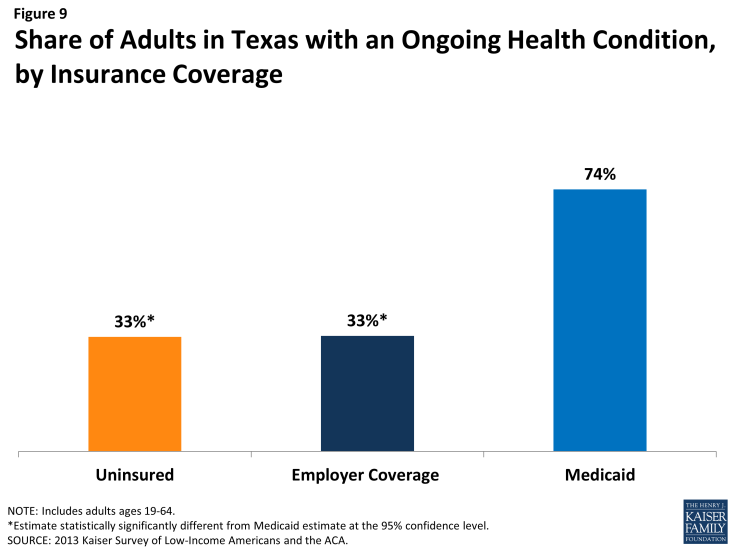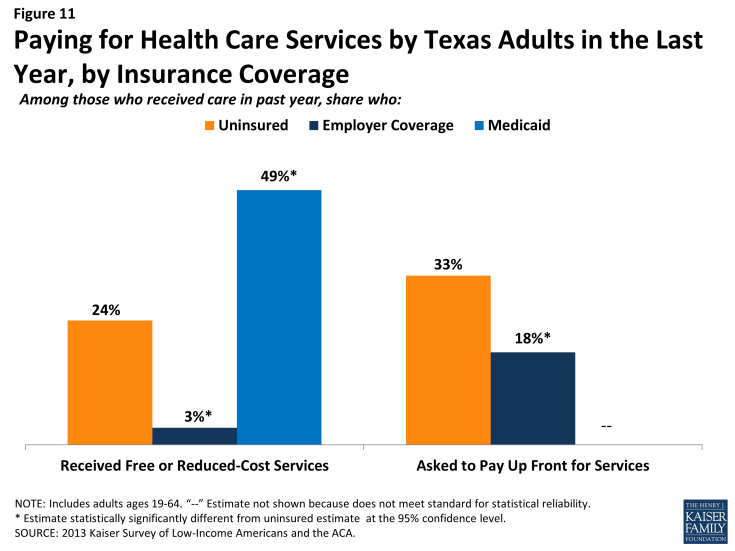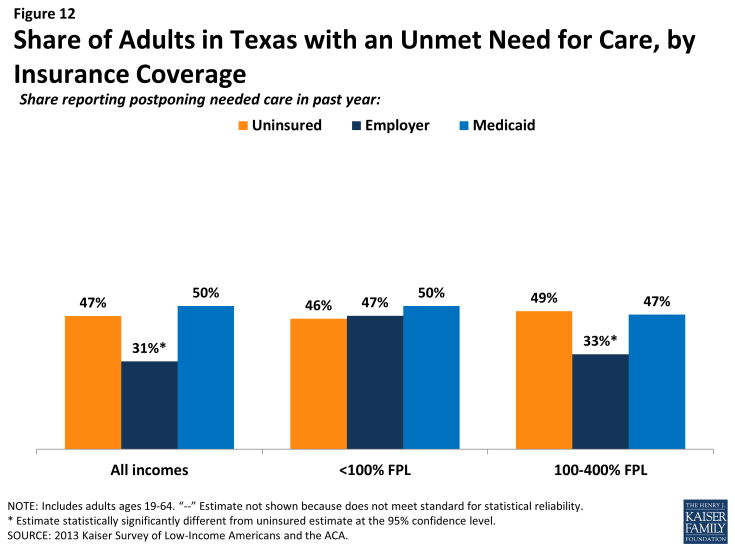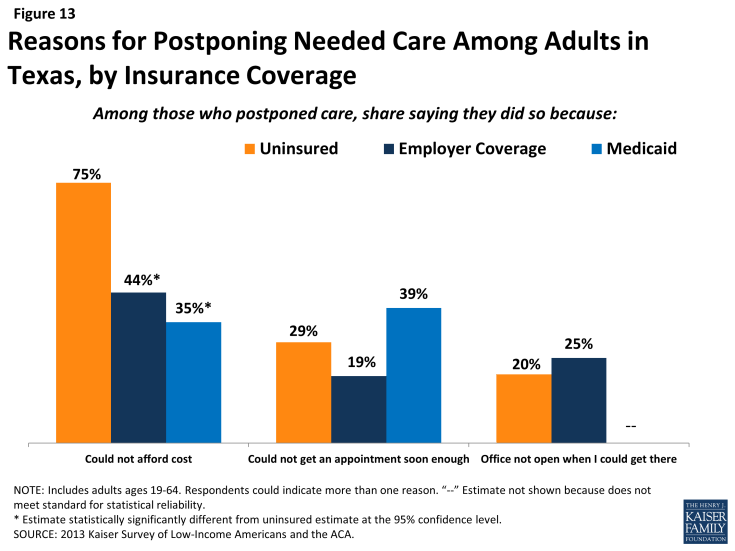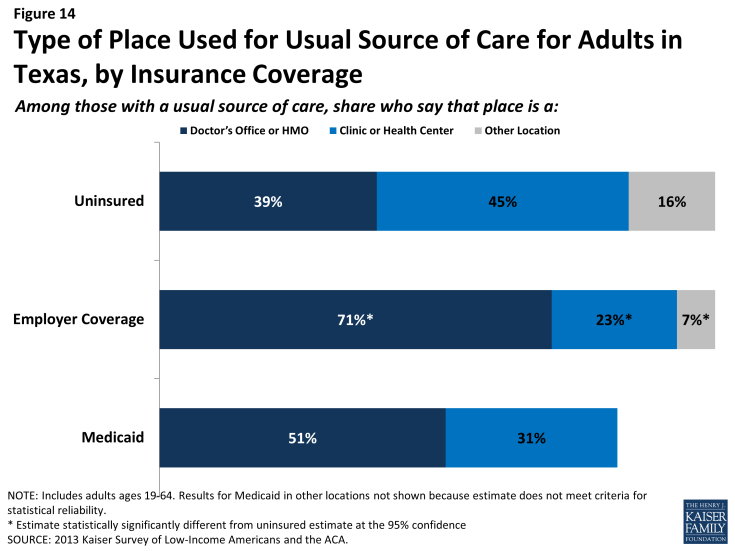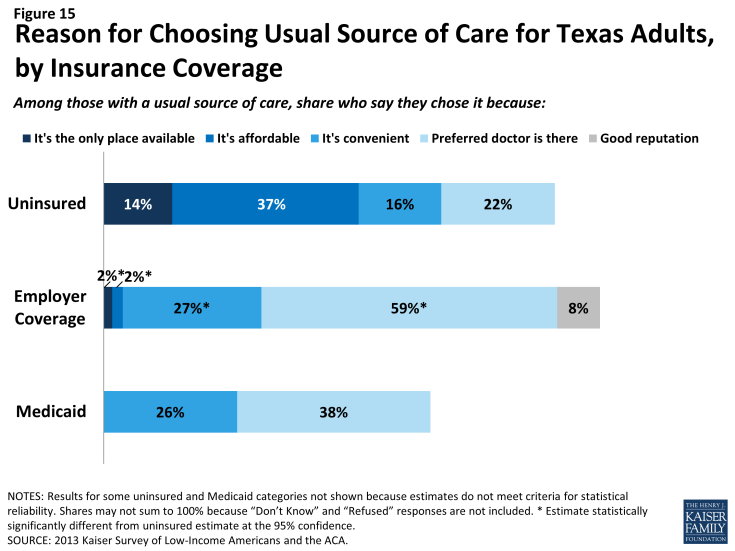The Uninsured Population in Texas: Understanding Coverage Needs and the Potential Impact of the Affordable Care Act
Access to Health Care Services Among Uninsured Adults in Texas
Uninsured adults in Texas generally do not seek or receive health care services at the same rate as insured adults, even when they have a need for care. Many uninsured adults have substantial health care needs that are not monitored by a physician. Cost is the main reason uninsured Texans do not receive care when needed, and many lack a regular provider to facilitate follow-up or ongoing care. When uninsured adults do receive care, they often have limited options. As coverage expands under the ACA, some uninsured adults are likely to get care more frequently and establish relationships with providers, yet many uninsured adults will remain without a coverage option and continue to have unmet need for care.
A large segment of the uninsured in Texas has little or no connection to the health care system.
While some uninsured adults in Texas do report receiving health care services, most report few connections to the health care system. Less than half of uninsured adults in Texas (48%) report that they have a usual source of care, or a place to go when sick or need advice about their health (not including the emergency room). Having a usual source of care is an indicator of being linked in to the health care system and having regular access to services. In comparison, nearly all insured adults in Texas —78% of those with employer coverage and 74% of those with Medicaid coverage— have a usual source of care (Figure 7). In addition, uninsured adults in Texas are less likely to have a regular doctor at their usual source of care, with 28% of uninsured adults reported having a regular doctor, well below the rate of insured adults. Notably, poor uninsured adults in Texas, most of whom fall in the coverage gap, are the least likely to have a usual source of care or a regular physician (Table 3).
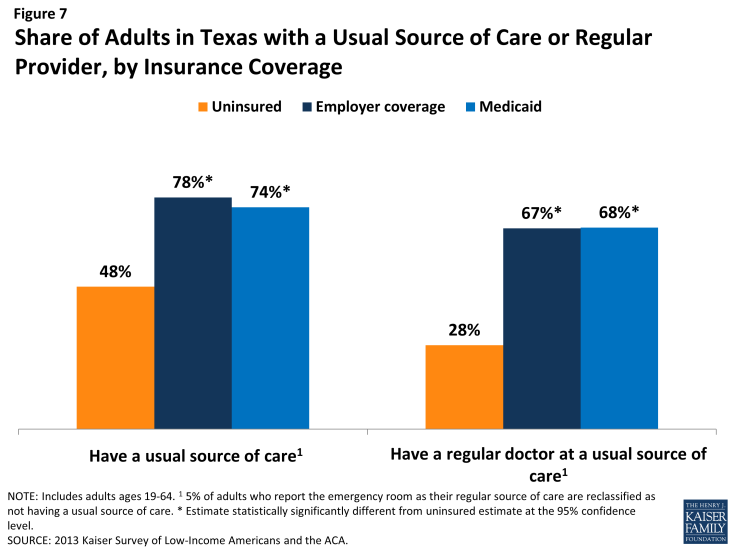
Figure 7: Share of Adults in Texas with a Usual Source of Care or Regular Provider, by Insurance Coverage
This lack of a connection to the health care system leads many uninsured adults in Texas to go without care. About six in ten uninsured adults in Texas (56%) reported a health care visit—including hospital visits, doctor’s office or clinic visits, mental health services, or trips to the emergency room— in the past year, compared to 89% of Medicaid beneficiaries and 85% of adults with employer coverage (Figure 8). Of particular concern is the lack of preventive visits among uninsured adults in Texas. Three in ten (31%) of uninsured adults reported a preventive visit with a physician in the last year, compared to 73% of adults with employer coverage and 71% of adults with Medicaid (data not shown).
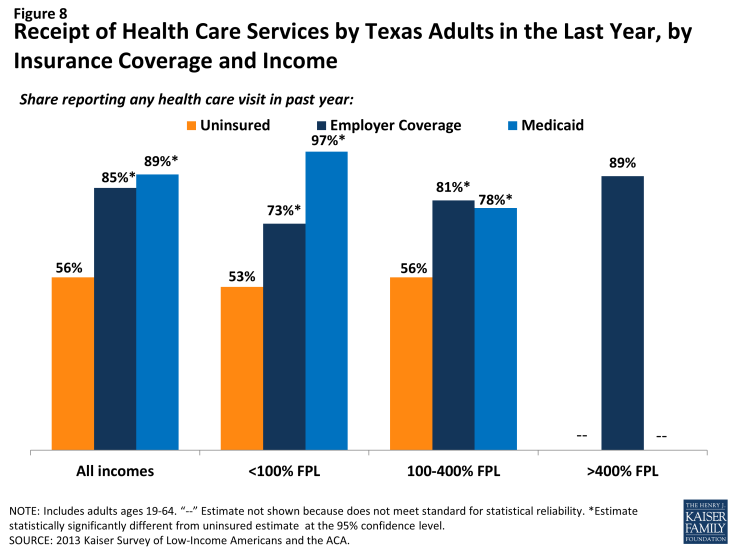
Figure 8: Receipt of Health Care Services by Texas Adults in the Last Year, by Insurance Coverage and Income
|
Table 3: Share of Adults in Texas with Usual Source of Care or Regular Provider,
by Income and Coverage
|
||||
| Uninsured | Insured | |||
| Employer | Medicaid | |||
| Has a usual source of care1 | ||||
| All | 48% | 78%* | 74%* | |
| By Income | ||||
| <100% FPL | 43% | 59% | 82%* | |
| 100-400% FPL | 48% | 76%* | 61% | |
| >400% FPL | — | 81% | — | |
| Has a regular provider at usual source of care1 | ||||
| All | 28% | 67%* | 68%* | |
| By Income | ||||
| <100% FPL | 24% | 49%* | 79%* | |
| 100-400% FPL | 28% | 63%* | 51%* | |
| >400% FPL | — | 72% | — | |
| NOTES: Don’t Know and Refused responses not shown. “–“: Estimates with relative standard errors greater than 30% or sample size too small for analysis are not provided. 15% of adults who report the emergency room as their regular source of care are reclassified as not having a usual source of care. *Estimate is statistically significantly different from uninsured estimate at the 95% confidence level. SOURCE: 2013 Kaiser Survey of Low-Income Americans and the ACA. |
||||
The survey findings reinforce conclusions based on prior research: having health insurance affects the way that people interact with the health care system, and people without insurance have poorer access to services than those with coverage.1,2,3 The remaining uninsured in Texas are likely to continue to face many of the barriers to health care that they had encountered previously, including a lack of usual sources of care, and a lack of preventative care.
Many uninsured Texans have health needs, many of which are unmet or are being met with difficulty.
Texans who lack health insurance still have health care needs. About three in ten (33%) uninsured adults reported an ongoing health condition, compared to 74% with Medicaid (Figure 9). Medicaid beneficiaries are most likely to report having an ongoing health condition of all coverage groups, which reflects Medicaid’s role in caring for people with substantial health needs, such as individuals with disabilities or people who become impoverished due to high health care expenses. These findings hold across income groups (Table 4).
| Table 4: Health Status of Adults, by Income and Coverage | ||||||
| Uninsured | Insured | |||||
| Employer Coverage | Medicaid | |||||
| Fair or Poor Overall Health | All Incomes | 40% | 11%* | 67%* | ||
| <100% FPL | 50% | — | 75%* | |||
| 100-400% FPL | 34% | 17%* | 55% | |||
| Fair or Poor Mental Health | All Incomes | 16% | 6%* | 28%* | ||
| <100% FPL | 22% | — | 42%* | |||
| 100-400% FPL | 12% | 11% | — | |||
|
Have ongoing health condition that
needs to be monitored regularly
or needs regular care
|
All Incomes | 33% | 33% | 74%* | ||
| <100% FPL | 31% | — | 84%* | |||
| 100-400% FPL | 29% | 30% | 60%* | |||
| Take prescription medication on regular basis1 | All Incomes | 31% | 44%* | 69%* | ||
| <100% FPL | 33% | — | 80%* | |||
| 100-400% FPL | 27% | 42%* | 50%* | |||
| NOTES: Don’t Know and Refused responses not shown. “–“: Estimates with relative standard errors greater than 30% or sample size too small for analysis are not provided. 1Excludes birth control. *Estimate statistically significantly different from uninsured estimate at the 95% confidence level. SOURCE: 2013 Kaiser Survey of Low-Income Americans and the ACA. |
||||||
While uninsured Texans with an ongoing health condition are more likely than those without to report receiving services (Figure 10), they are still less likely than their insured counterparts to receive care. Less than half (43%) of uninsured adults without an ongoing health condition say they received health care services in the last year, and more than eight in ten (83%) uninsured adults with a health condition received health care services. However, the latter rate is still lower than adults who have a health condition and have employer coverage or Medicaid, nearly all of whom (97% and 97%, respectively) reported receiving medical services over the course of the year.
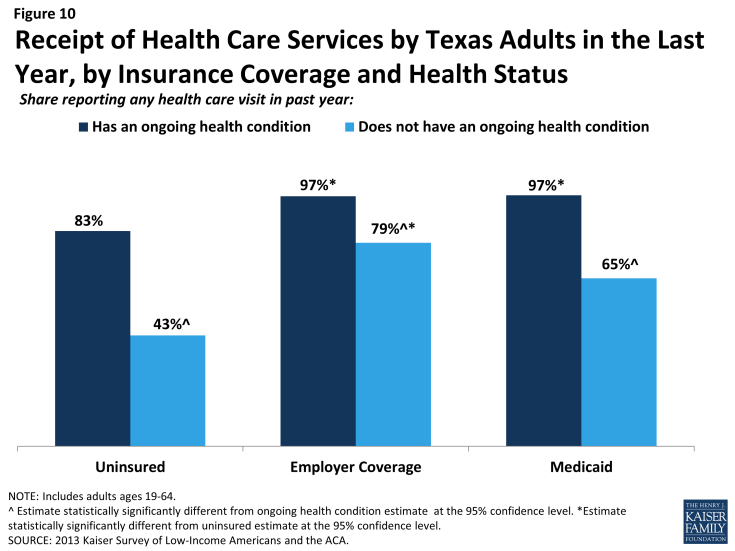
Figure 10: Receipt of Health Care Services by Texas Adults in the Last Year, by Insurance Coverage and Health Status
When uninsured Texans do receive care, they sometimes receive free or reduced-cost care, though the majority does not. Among adults in Texas who reported that they received a health care service in the past year, 24% of uninsured adults in Texas reported receiving free or reduced cost care, versus just 3% of those with employer coverage (Figure 11). Notably, 49% of adults with Medicaid who received services reported that they received free or reduced cost care. They may have done so during a period of uninsurance in the previous year or may associate the fact that they pay little or no costs when they see a provider as receiving “free or reduced cost” care. Uninsured adults in Texas who received care were much more likely than their insured counterparts to be asked to pay up front for care: one-third (33%) reported being asked to pay for the full cost of medical care (not counting copayments) before they could see the doctor or provider, compared to just 18% of those with employer coverage. Adults with employer coverage may have experienced these issues during a period in the past year when they lacked coverage or when using a service not covered by their insurance.
Although some uninsured and insured adults in Texas reported receiving free or reduced cost health care services, a larger share reported an unmet need for care. Nearly half (47%) of the uninsured and Medicaid (50%) beneficiaries in Texas reported needing but postponing care, compared to 31% of adults with employer coverage (Figure 12).
The most common reason for postponing care among uninsured Texans is cost (75%). Adults with employer coverage (44%) or Medicaid (35%) are less likely to report cost as a reason for postponing care because presumably their insurance pays most or all of that cost (Figure 13). However, adults with employer coverage or Medicaid may report postponing care due to cost if their health insurance does not cover a specific treatment that they need. Appointment availability was also reported as a significant reason for postponing care. Almost four in ten adults with Medicaid (39%) and nearly three in ten uninsured adults (29%) reported postponing care because they could not get an appointment soon enough. A quarter of adults with employer coverage reported that the office not being open when they could get there as a reason for postponing. Many physicians do not have hours outside of the normal workday, so some working adults may need to take time off to get care.
As resources and attention shift to the newly-insured population, individuals left out of coverage expansions (such as poor adults) will continue to have health needs. The ACA included funds to expand service capacity in medically underserved areas, including expansion of community health centers, nurse-managed health centers, and school-based clinics. To meet the health care needs of both insured and uninsured individuals, these systems will be challenged to develop flexible treatment times and new models of care to accommodate people’s availability and to expand capacity in areas where low-income individuals reside or seek care.
Many uninsured Texans reported limited options for receiving health care when they need it.
Uninsured adults in Texas are less likely than their insured counterparts to receive care in a private physician’s office. Uninsured adults in Texas are also more likely to go to a clinic or health center than a private physician’s office when receiving care. Nearly four in ten (39%) uninsured Texas adults who have a regular source of care reported that it is a physician’s office or HMO, compared to over seven in ten (71%) of adults with employer coverage (Figure 14). Meanwhile, 45% of uninsured adults in Texas who have a regular source of care reported clinics or health centers as their usual source of care, nearly twice as high as adults with employer coverage (23%). Notably, 17% of uninsured adults in Texas reported the emergency room as their usual source of care – substantially higher than adults with private insurance (data not shown).
Uninsured adults in Texas are more likely than other adults to report that they have limited options for their usual source of care. Among people with a usual source of care, 37% of the uninsured reported that they chose their usual source of care because it is affordable, compared to 2% with employer coverage (Figure 15). Adults with employer coverage are more likely to choose a site of care based on the ability to see their preferred provider compared to uninsured adults. Most of those who say they chose their usual source of care based on cost chose to go to a clinic or health center, reflecting the fact that these providers often have a mission to serve low-income populations and offer services with sliding scale fees.4


